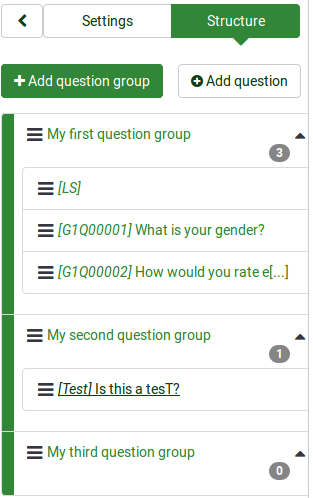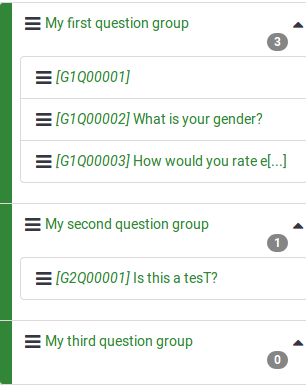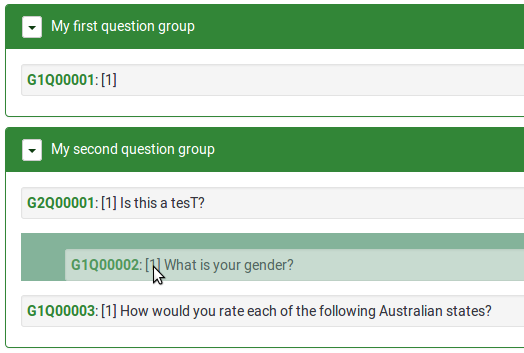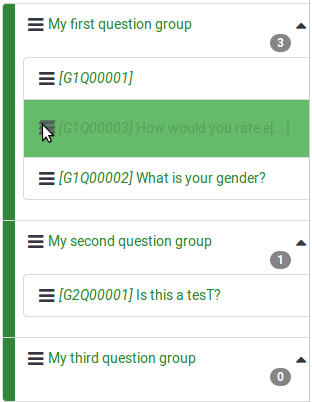Survey structure: Difference between revisions
From LimeSurvey Manual
mNo edit summary |
mNo edit summary |
||
| Line 10: | Line 10: | ||
=Introduction= | =Introduction= | ||
When you access a survey, the [[Survey settings|Survey Settings menu]] is selected by default. In order to access the '''Survey Structure''', click on the '''Structure''' button located near the '''Settings | When you access a survey, the [[Survey settings|Survey Settings menu]] is selected by default. In order to access the '''Survey Structure''', click on the '''Structure''' button located near the '''Settings''' tab: | ||
<center>[[File:Survey structure basics.png]]</center> | <center>[[File:Survey structure basics.png]]</center> | ||
The current structure of your survey will be displayed. As you can see in the screenshot from above, there are three question groups and four questions. | |||
To better order them (and make it look prettier), you can use the '''regenerate question codes''' function of LimeSurvey. This will automatically re-numerate the your questions and question groups: | |||
| Line 27: | Line 26: | ||
You can add from the '''Survey Structure''' menu [[Question groups - introduction|question groups]] and [[Questions - introduction|questions]]. To find out more information about these options, continue reading the next [[Survey structure#The structure of a survey|wiki section]]. | |||
=The structure of a survey= | =The structure of a survey= | ||
'''A survey is formed of questions and question groups'''. They represent the | '''A survey is formed of questions and question groups'''. They represent the backbone of a survey. Besides that, a survey may also contain: | ||
* | * the main and additional survey languages | ||
* Question attributes | * Question attributes | ||
* Answers | * Answers | ||
| Line 45: | Line 44: | ||
* Survey-specific settings | * Survey-specific settings | ||
Everything mentioned above is | Everything mentioned above is includen in the .lsa and/or .lss file. These file types allow users to easily import and export surveys into/from their LimeSurvey installation. | ||
Different settings such as themes, survey participants tables, resources or label sets have to be separately exported and then imported into | Different settings such as themes, survey participants tables, resources or label sets have to be separately exported and then imported into another survey. | ||
| Line 55: | Line 54: | ||
=Question groups= | =Question groups= | ||
Before you start adding questions to a survey, you need to have at least one question group created. Then, all your new questions will be added to this question group. | |||
To find out more about question groups, | To find out more about question groups, read our [[Question groups - introduction|introduction on question groups]]. | ||
=Questions= | =Questions= | ||
Once a question group is created, you can start adding questions. To | Once a question group is created, you can start adding questions. To quickly check the question types you can use within a survey, continue reading the following [[Question types|wiki page]]. | ||
If you want to learn more about | If you want to learn more about question fields, read our [[Questions - introduction|introduction on questions]] | ||
| Line 71: | Line 70: | ||
The system through which you change the order of the questions and question groups was slightly changed in LimeSurvey 3. | The system through which you change the order of the questions and question groups was slightly changed in LimeSurvey 3. | ||
In LimeSurvey 2, you have to click on the '''Survey''' button to access the home page of the survey and select | In LimeSurvey 2, you have to click on the '''Survey''' button to access the home page of the survey and select the '''Question organizer''' option. Then, the following page will be loaded: | ||
| Line 77: | Line 76: | ||
You can update the order of all your questions and question groups from here, or move some questions from one group to another one. To start reordering questions and/or question groups, simply click | You can update the order of all your questions and question groups from here, or move some questions from one group to another one. To start reordering questions and/or question groups, simply click and drag each of them to the desired position. | ||
| Line 83: | Line 82: | ||
In LimeSurvey 3, you can change the order of the questions and question groups from the '''Survey Structure''' menu. Once accessed, click on the three-lines symbol | In LimeSurvey 3, you can change the order of the questions and question groups from the '''Survey Structure''' menu. Once accessed, click on the three-lines symbol that is located in front of the question (group) name and start dragging it to the desired position. | ||
| Line 89: | Line 88: | ||
{{Alert|title=Attention|text=Questions are displayed according to the order you set from the "reordering panel". However, | {{Alert|title=Attention|text=Questions are displayed according to the order you set from the "reordering panel". However, conditions might prevent the reordering of the questions. In this case, you will have to delete or change the respective conditions first.}} | ||
</translate> | </translate> | ||
Revision as of 15:43, 14 December 2017
Introduction
When you access a survey, the Survey Settings menu is selected by default. In order to access the Survey Structure, click on the Structure button located near the Settings tab:

The current structure of your survey will be displayed. As you can see in the screenshot from above, there are three question groups and four questions.
To better order them (and make it look prettier), you can use the regenerate question codes function of LimeSurvey. This will automatically re-numerate the your questions and question groups:

You can add from the Survey Structure menu question groups and questions. To find out more information about these options, continue reading the next wiki section.
The structure of a survey
A survey is formed of questions and question groups. They represent the backbone of a survey. Besides that, a survey may also contain:
- the main and additional survey languages
- Question attributes
- Answers
- Subquestions
- Default answers
- Assessments
- Quotas
- Quota members
- Quota language settings
- Survey users and their permissions
- Survey-specific settings
Everything mentioned above is includen in the .lsa and/or .lss file. These file types allow users to easily import and export surveys into/from their LimeSurvey installation.
Different settings such as themes, survey participants tables, resources or label sets have to be separately exported and then imported into another survey.
Question groups
Before you start adding questions to a survey, you need to have at least one question group created. Then, all your new questions will be added to this question group.
To find out more about question groups, read our introduction on question groups.
Questions
Once a question group is created, you can start adding questions. To quickly check the question types you can use within a survey, continue reading the following wiki page.
If you want to learn more about question fields, read our introduction on questions
Reordering questions and question groups
The system through which you change the order of the questions and question groups was slightly changed in LimeSurvey 3.
In LimeSurvey 2, you have to click on the Survey button to access the home page of the survey and select the Question organizer option. Then, the following page will be loaded:

You can update the order of all your questions and question groups from here, or move some questions from one group to another one. To start reordering questions and/or question groups, simply click and drag each of them to the desired position.
In LimeSurvey 3, you can change the order of the questions and question groups from the Survey Structure menu. Once accessed, click on the three-lines symbol that is located in front of the question (group) name and start dragging it to the desired position.
